Overtaking, Applying science and commonsense
Partialy From Grandprix.com
(Keep in mind that this article was created on the end of 2008)
Overtaking is not just about the tracks. It is also related to the cars. On some circuits overtaking is possible, even with the modern machinery. On others it is not. Changing the circuits may help but a lot of F1 engineers believe that changing the cars will have a much bigger effect on the ability of the drivers to pass one another.
Overtaking opportunities in "downforce cars" are notoriously few. If you drive close, you will lose the air over the front wing, and trough the corner you can understeer wide. Runing wide compound loss of grip because you end up on dirty part of the track that was rarely driven on, typicaly covered with "marbles" - chunks of rubber of various sizes that had the same effect as stepping on a banana skin.
In the old days a cars would arrive behind a rival machine and would be able to tuck into the slipstream and be sucked along by the car ahead. If a driver can use this 'tow' he could pull out and employ the extra revs of his engine to get ahead. This created some celebrated 'sliptreamer' races at places like Reims and Monza, and some every close finishes.
In the late 1960s, however, designers began adding wings to use the airflow to create force to push the cars down on to the tarmac. This meant that they would no longer slide in the corners and thus would lap more quickly. And so began the relentless pursuit for downforce in Formula 1. In the late 1970s engineers at Team Lotus took the process a step further and applied a principle established in the Eighteenth Century by Swiss mathematician Daniel Bernoulli to use airflows around the car to create a low pressure area under the car to 'suck' the car to the ground. They used sidepods to achieve this and later added flexible 'skirts' to the bottom edges of the sidepods in order to separate and seal the different airflows more efficiently. The Lotus 79 in 1978 was a hugely important (and very successful) F1 car, but it let the genie out of the bottle. Aerodynamics became the key element of Formula 1 design. The FIA responded by banning skirts and then mandating flat-bottomed cars to stop aerodynamicists creating downforce-generating underbodies. As the designers worked to improve their cars they did not care what happened to the airflow behind the cars they were creating. However the drivers began to find that running in disturbed 'dirty' air meant that theirs cars lost around 40% of the downforce, and that meant that they could catch the car in front but as soon as they arrived in its wake, they were trapped.
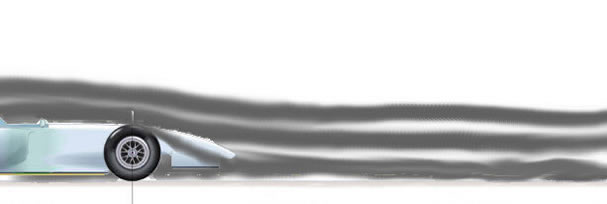 |
Formula 1 car in clean undisturbed air can take full advantage of aerodynamic grip of his car. This situation normally occur when driver is leading the race, or distance to the car in front is at least 1,5 seconds. In this cases overtaking is anyway not possible because distance to the car in front is to big. |
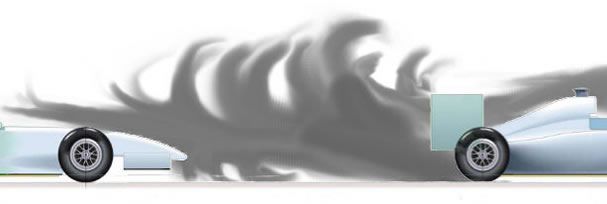 |
A common complaint of many F1 fans is the perceived lack of overtaking in the sport, especially compared to other forms of racing such as touring cars. The main reason for this deficiency is the advanced aerodynamics of an F1 car in that, when one car closely follows another, it has to re-use the air of the car in front. For good overall grip you need both good aerodynamic grip and mechanical grip. This so-called dirty air has already been displaced and manipulated by the leading car and, when receiving it ‘second-hand’, the car following cannot take full advantage of it. As a result, the car behind experiences decreased aerodynamic grip, and struggles to keep close enough to its rival to mount a successful challenge for the position. He needs to relay almost entirely on car mechanical grip, and that’s not enough. |
Overtaking became more and more difficult and races began to get less spectacular than once they had been.
 |
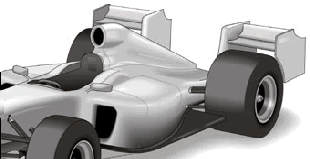 |
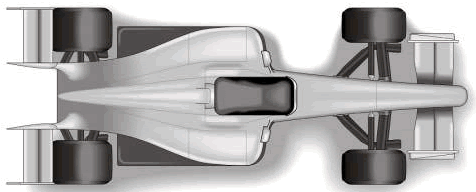 |
|
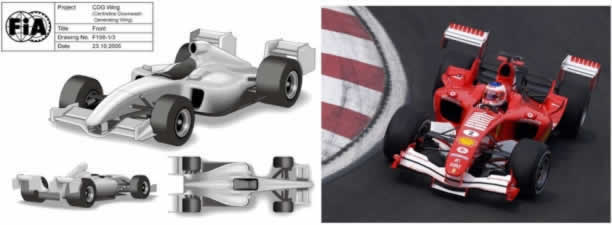 |
|
F1 Centre Downwash Generating Wing, one of the FIA "great ideas" and Ferrari prototype |
|
In the end the FIA began to look for car shapes that might create a wake in which a following car would gain an advantage, as in the old slipstream days.
In 2005 FIA President Max Mosley commissioned his former partner Nick Wirth, a designer who had worked with the Simtek and Renault F1 teams, to come up with an idea of how to lower aerodynamic turbulence behind the cars and by doing so create more overtaking. Wirth worked with computational fluid dynamics (CFD) programmes to come up with what he called the Centreline Downwash Generating (CDG) wing. The FIA announced that it would introduce the CDG wing in 2008.
At the time the Technical Working Group, working with the Grand Prix Manufacturers' Association (GPMA) used the Italian Fondtech wind tunnel, run by former Ferrari and Tyrrell aerodynamicist Jean-Claude Migeot, to see if the CDG wing would work. Migeot and his team concluded that the idea was flawed. By the autumn of 2006 no-one had much confidence in the CDG wing and Mosley agreed that its introduction could be delayed and that the Technical Working Group should come up with a better idea for 2009.
The Technical Working Group met to discuss the question that autumn. All the teams sent technical directors, seniors engineer and aerodynamicists. There were thus 25 opinions to be heard (as Prodrive was still planning to enter F1 at that point and Super Aguri was still in business). The meeting was chaired by Charlie Whiting and after hours of different opinions he decided that it was a pointless exercise. He concluded that the only way forward was to create a sub-group and allow only the top three teams to be represented. Ferrari, Renault and McLaren were each invited to nominate a representative. Thus was born the Overtaking Working Group (OWG).
Pat Symonds of Renault, Rory Byrne of Ferrari and Paddy Lowe of McLaren were all well-established engineers of repute and all were keen to get the job done using commonsense and a scientific approach. The OWG met for the first time in January 2007. They cut straight to the chase. They defined the downforce targets they were looking to achieve and the character of the aerodynamics that was required to improve overtaking. Whiting provided data which had been averaged out from information he had been given by all the teams. The aim was make the cars five seconds a lap slower, but they had to factor in other progress and the reintroduction of slick tires, planned for 2009. This meant that the OWG was looking for very significant changes. The conclusion was that they needed to reduce downforce by 50 per cent while retaining similar drag coefficients to the 2006 car.
The first move was to use McLaren's highly advanced simulator to establish baseline aerodynamic performance parameters. McLaren test driver Pedro de la Rosa was called in to 'drive' the simulator and after recording a series of different laps with different settings it was determined that in order to overtake going into Turn 1 he would need to have a car that was two seconds a lap quicker than the one in front. The engineers paid great attention to de la Rosa's comments. He would try each configuration and report on whether the resulting set-up would allow him to attempt to pass or not. Halving the downforce meant that the necessary 'overtaking advantage' figure could be reduced to 1.5s a lap and the work then moved on to finding ways to balance the following car to reduce the necessary 'overtaking advantage' to a second. The three engineers all agreed that this was a realistic figure, rather than trying to make it even easier to overtake.
At the same time that this was going on, Symonds was sent off to talk money out of Renault team principal Flavio Briatore and the other 11 team bosses. The result was a budget of half a million Euros. The trio had agreed that they should use Fondtech to do windtunnel work for them and that they did not want to place too much faith in CFD. It was an interesting technology but it was not ready for this kind of work as it was not possible to use CFD to study unstable behaviour of the air behind a car. The McLaren simulator, which represented 30man/years of development proved a far more flexible tool than other simulations and used a real driver (Pedro) to get a subjective view.
Once they had established the basic data and the targets required, the OWG asked Fondtech to devise means by which the desired changes might be achieved. Ferrari provided baseline data for the two models that Fondtech ran in tandem in its 25 per cent moving ground wind tunnel. They in turn had drawn on an experiment by Ferrari at Monza in 2004, when it ran two cars in tandem round the autodromo. This full-scale Ferrari data was used to validate the twin model behaviour in the tunnel, in turn to validate the entire experimental technique. This was a very important step, that justified the use of tunnel rather than CFD.
Between March and September 2007 there were several sessions in the wind tunnel, with Byrne doing much of the hands-on work and all sorts of ideas were investigated. The final configuration pretty much hit its targets though baseline drag fell by 10 per cent.
The next step was to feed the actual data back into the McLaren simulator in order to compare it with the baseline model that had been established. De la Rosa confirmed the benefits in terms of improved chances to overtake. The OWG made its presentations to the TWG in October 2007 and the teams agreed to accept them.
What was interesting was that by using a scientific approach to the problem it became clear that previous attempts to solve the problem had in reality made things worse.
"Almost all of the attempts to reduce downforce in the recent past have been retrograde in terms of overtaking possibilities and wake behaviour," one member of the OWG said. "If we had wanted to make overtaking chances worse, that was what we would have come up with."
One of the most significant findings was that the rear wing is a very important device in characterising the wake that a car generates.
"You would think that upwash from the rear wing is bad," Lowe said. "The upwash is strong, but a very strong inwash at ground level is also driven by the rear wing. That inwash brings new high-energy air in at ground level. If you took the rear wing off altogether you would lose that effect and the wake would be a lot worse."
The OWG found that a 75 per cent narrower and 150 mm higher rear wing would optimise the new air.
Nick Wirth's computational fluid dynamics (CFD)-generated rear wing had eliminated the central section altogether, effectively comprising instead two separate rear wings, to eliminate the upwash, but the OWG concluded that this was the very reason that it did not work.
Having determined the best possible rear wing configuration to generate the least damaging wake, the OWG moved on to determine the optimum front wing and floor for the following car. Lots of different floor shapes were tried, including underbody tunnels and other radical ideas, but the OWG found that the best solution was similar to that on the current cars, but with the diffuser section mounted further back to use more of the benefit of the inwash air.
The front wing will thus be lowered and, at 1800 mm, will be 400 mm wider than on the 2008 car. The most important point, however, is that the aerodynamic profile of the central section of the front wing will be fixed so that it remains neutral and does not generate downforce. This is because the central section of the wing is the most badly affected by the central upwash of the wake, and is the last part of the wing to receive the fresh high-energy air from the ground level inwash. By disabling this section, this effect is eliminated. Conversely, the wider outboard and lower extremities of the new front wings benefit more from the high-energy inwash air. This all helps to maintain the good level of downforce and thus to manage the following car's balance better while it is running in a wake of the car in front.
Another crucial development of the front wing, however, is to allow the front flap to be adjustable while the car is in motion, although only by plus or minus three degrees. This was deemed necessary because of the problem of oversteer in the wake of another car.
"That would be a complete disaster," Lowe said. "The driver of that car is going to fall off. We were worried that we were not going to be able to control that, so we went for the adjustable front flap. The driver will only be allowed to change the angle twice a lap, if necessary to reduce frontal downforce to prevent oversteer in the wake, or else to trim out any remaining understeer if that is how his car behaves."
That system will all be controlled by the standard FIA electronic control unit (ECU), so nobody will be able to adjust their front wing more than twice each lap. Effectively that will also oblige the driver to chose his overtaking opportunity carefully on any given lap, and is in keeping with the OWG's desire that overtaking should not become too easy.
The new rules will exclude all the barge boards, the radiator air extraction chimneys, flip-ups, nose horns and all the rest of it. The plan is for the cars to be smooth between the axles.
"There is a small overtaking benefit attached to that," Lowe admitted, "but it was mainly done in response to demands from the team principals for cleaner advertising areas."
However, the most significant element of the research is probably not the technology nor the commercial advantages.
"Getting the three top teams to work so closely together was a real first," said Lowe.
Something altogether unexpected...
The regulation changes for 2009 are some of the most extensive ever introduced to Formula One racing and fall into three main areas - aerodynamics, KERS and tires. Formulated with help from the Overtaking Working Group's (OWG) engineers, the new rules aim to (1) reduce the aerodynamic sensitivity of the cars to turbulence; (2) increase overtaking opportunities; and (3) slow the cars in the very quick corners. To compensate for the loss of downforce from the aerodynamic changes, slick tires have been brought back for the first time since 1997 to boost mechanical grip. As a result of the changes the 2009 cars appear quite different to their predecessors, with the removal of the vast majority of bargeboards (now only allowed in a very small area), winglets, chimneys and cooling gills leading to much cleaner looking designs.
Williams was first to give us an idea of how the 2009 F1 regulation changes will affect the look of the cars. Williams were spotted douring the testing at Jerez 19 September 2008 with a 2009 spec rear-wing on the FW30, as well as elements of the new front wing configuration. It can clearly be seen that the new rear wing is considerably taller and narrower than the current item. The images give us the best idea yet of how cars will look for 2009, although how efective these changes will be in encouraging overtaking in F1 has yet to be seen.
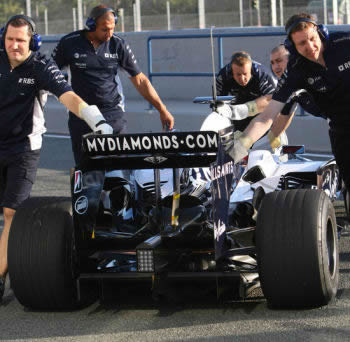

As part of the aero changes designed to allow cars to be able to follow each other more closely (and hence promote overtaking), the 2009 front wing is both lower (75mm instead of 150mm) and wider (1800mm instead of 1400mm). The wing also features a universal central section (500mm), which all teams' designs must comply with this season, and a flap section that can be adjusted by the driver twice a lap over a range of six degrees (+/- 3 degrees).
The rear wing becomes taller (up 150mm to bring it level with the top of the engine cover) and narrower (750mm from 1000mm).
 In next few pictures we can see estimate of how will look 2009 Ferrari. Car is designed to meet new aerodynamic regulations. The main caracteristics of the new regulations are a reduction in the hight and increase in the width of the front wing. In the same time increase in the hight and reduction of the width of the rear wing. All upper body elements and aero devices such as turning wanes, winglets, chimneys and flip-ups have been baned, and underbody diffuser dimension are longer and higher, with the device moved rearwards. This aero changes will run in tandem with slick tires and oppotunity to use KERS
In next few pictures we can see estimate of how will look 2009 Ferrari. Car is designed to meet new aerodynamic regulations. The main caracteristics of the new regulations are a reduction in the hight and increase in the width of the front wing. In the same time increase in the hight and reduction of the width of the rear wing. All upper body elements and aero devices such as turning wanes, winglets, chimneys and flip-ups have been baned, and underbody diffuser dimension are longer and higher, with the device moved rearwards. This aero changes will run in tandem with slick tires and oppotunity to use KERS
 From overhead, the clearest difference between the 2008 and 2009 designs is the increased width of the front wing, now as wide as the car itself at 1800mm. Gone are the fairings on the front suspension pick-up points (where the suspension attaches to the chassis) and the use of turning vanes is now restricted to a small triangular section (see arrow) in front of the sidepods.
From overhead, the clearest difference between the 2008 and 2009 designs is the increased width of the front wing, now as wide as the car itself at 1800mm. Gone are the fairings on the front suspension pick-up points (where the suspension attaches to the chassis) and the use of turning vanes is now restricted to a small triangular section (see arrow) in front of the sidepods.
Cooling vents, chimneys and winglets are noticeably absent from the top of the sidepods and there is no winglet on top of the rear axle. The rear wing is narrower (750mm instead of 1000mm) and taller (950mm as opposed to 800mm) and the diffuser has been moved further back.

Added on the begining of 2011
On the end of 2010, the FIA’s World Motor Sport Council has agreed a number of significant changes to the Formula One regulations. Among them are a new single tyre supplier, aerodynamic revisions designed to boost overtaking, a ban on F-ducts, and the return of a 107% qualifying rule.
A great overtaking move is one of the most thrilling sights during a Grand Prix, but critics have argued for some time, and that rightfully, that passing has become too difficult for even the world’s best drivers. Recent attempts by the FIA and engineers to develop technology to help drivers pass rivals have enjoyed variable success, but teams are hopeful this season's moveable rear wings could achieve much more.
In 2011 drivers will be able to adjust their car’s rear wing from the cockpit, thereby boosting their top speed and increasing their chances of overtaking the car ahead. McLaren’s director of engineering, Paddy Lowe, is amongst those who believe this new concept will enjoy more success than 2010's moveable front wing, which has been dropped for this season.
“It has a lot more leverage,” Lowe explained. “The adjustable front wing was introduced along with the OWG (Overtaking Work Group) regulations in 2009 and it was really only intended as a mild adjustment for a driver to trim the balance of the car when in the wake and while attempting to overtake another car.
“I was a member of the OWG and we actually put it in there as an insurance policy as we were all a bit worried that if we had got it wrong the car would be very unbalanced in the wake and possibly have oversteer. As it turned out nobody used the front wing for that purpose at all, we only really used it to make mild adjustments during the race for balance. So we all agreed last year that we would get rid of it in the interests of simplicity and cost saving because it would be the same for everybody.”
Although some have voiced concerns the new rear wings may make passing too easy and racing a bit artificial, there are restrictions on its use, which should present a real challenge to teams and drivers. Under new moveable bodywork regulations for next season, drivers will be able to adjust the rear wing from the cockpit as soon as they are two laps into the race. The system’s availability will be electronically governed and during the race can only be activated when a driver is less than one second behind another car at pre-determined points on the track. The system will then be deactivated once the driver brakes. It will be available at all times throughout practice and qualifying.
These ‘deployment points’ will be specified by the FIA on a race-by-race basis. And while Lowe believes the season may be a couple of races old before the stewards are happy they are implementing the new technology in optimum fashion, he doesn’t doubt the objectives of the changes will be realized.
“We are going to have to see and explore (its effects) throughout the season,” he explained. “I think it will be quite exciting. The one control that the FIA have is for each circuit they can set the points in the deployment straights at which you are allowed to press the button. So, for instance, you might be allowed to press it for the last 300m of the main straight until the braking point.
“I think the FIA have it within their power to manage the situation so that the authority of the system makes sense and that may take one or two races to settle down. But they can lengthen or shorten that amount of straight on a race-by-race basis so that will give some ability to make it work in the way we intended it to.”
In 2011, a driver’s overtaking arsenal will also include Kinetic Energy Recovery Systems (KERS), which return after a mutually-agreed suspension in 2010. KERS turns the waste energy generated under braking into additional power, which is then made available to the driver via a steering wheel-mounted ‘boost button’.
When used in combination with an adjustable rear wing, it should enable a driver to pass a rival who may have track advantage but doesn’t necessarily have a speed advantage.
Over at McLaren rivals Ferrari, driver Fernando Alonso is certainly excited by the prospect, even if he has concerns about the complexity of carrying out so many car adjustments at once.
“For years changes to the regulations have been brought in with this objective of more overtaking, but they haven’t always worked,” said Alonso. “We’re crossing our fingers but I think that between KERS and the adjustable rear wing there will be enough difference in speed to be able to overtake a car you’re fighting.
"These changes have been brought in after meticulous work on the part of the Technical Working Group and I believe they will work. They will be more complex to handle on the part of the driver because we will have more operations to carry out. You will need to find the way to adapt and find the right mechanisms for the buttons to avoid losing the correct concentration for driving.”
World Motor Sport Council decisions:
Driver adjustable bodywork
From 2011, adjustable bodywork (rear wing) may be activated by the driver at any time prior to the start of the race and, for the sole purpose of improving overtaking opportunities during the race, after the driver has completed two laps. The driver may only activate the adjustable bodywork in the race when he has been notified via the control electronics that it is enabled. It will only be enabled if the driver is less than one second behind another at any of the pre-determined positions around each circuit. The system will be disabled the first time the driver uses the brakes after the system has been activated. The FIA may, after consulting all the competitors, adjust the time proximity in order to ensure the purpose of the adjustable bodywork is met.
Front wing adjustment is not aloved any more.
Data issued by MercedesGP on the end of 2011 season
With DRS Formula One has made an effort to increase the possibility for overtaking.
Overtaking - how much, not enough, or too much of the artificial sort - a frequent topic throughout the 2011 season, since the advent of DRS (the Drag Reduction System) and Pirelli tires.
But overall levels of overtaking have risen to record levels - there have been nearly 1500 passes during 2011 season. The figures used below are calculated for strategic purposes by Mercedes team, which are reflected in the categorization, and compiled from a combination of video, timing data and GPS technology. Here I will not use data for overtaking trough pit stops, first lap or lapping slowest cars or passing damaged cars. Only clean racings (battle between two or more cars) are counted.
- The combined total of 'Normal' and 'DRS-assisted' moves - the indicator of what most observers consider to be 'clean' overtaking - is 804 overtakes. This gives an average of 45 normal and DRS overtakes per race.
- From the total of 804 clean overtakes, there have been 441 normal overtakes and 363 DRS overtakes; 55% were normal and 45% were DRS.
- The highest number of clean overtakes were recorded in Turkey (85), Canada (79) and China (67). The races with the fewest were Monaco (16), Australia (17) and India (18). Nine races featured fewer than 50 clean overtakes; eight races featured more than 50. There have been an average of 45 clean overtakes per race - broken down to 25 normal overtakes and 20 with DRS.
- The highest ratio of DRS overtakes to normal, i.e. where the influence of DRS was greatest, were: Abu Dhabi (89%), Europe (81%), India (78%), Turkey (59%) and Spain (57%). The lowest ratio of DRS overtakes to normal were: Monaco (13%), Hungary (20%), Canada (22%), Japan (26%) and Great Britain (27%) - it should be noted that three of these five races featured wet or mixed conditions, and use of DRS was restricted for portions of the race in Canada and Great Britain. DRS overtakes have outnumbered normal moves in eight of 18 races.
- In the first nine races of the season, there were on average 21 DRS overtakes per race - on average, 45% of clean overtakes. The influence of DRS has remained stable in the second nine races of the year: there were on average 20 DRS overtakes per race, representing on average 46% of clean overtakes.
- The most overtaking in the races after lap one list is headed by Perez and Buemi, both with 82 overtakes. They are followed by Button (77), Webber (76), Alguersuari (74) and Michael Schumacher (71). It should be noted that use of DRS is allowed after second lap.
- Most overtaking manoeuvres in a dry race (= most ever): 126 at the 2011 Turkish Grand Prix
- Most overtaking manoeuvres in a wet race (= most ever): 125 at the 2011 Canadian Grand Prix
Of this year's overtaking maneuvers, a lot have been assisted by DRS, but it has also set up opportunities to pass later in the lap. I think DRS on its own is good but personally I feel that having KERS has really helped this year. I think they can really use it to their advantage, to overtake and obviously to try and block and defend a position. That’s meant that KERS was as important as DRS. There are some instances when perhaps it made overtaking too easy, but there are always negatives and positives with something new like this. Positives outweigh the negatives. DRS and KERS has brought a lot to racing, and you can get closer to the cars ahead and prepare your next move. System has worked very well and it will get even better next year now the FIA knows how it works.
During 2014 season Belgium GP at Spa interview, Adrian Newey, at Edd Straw (Autosport) question: "Formula One cars aren't as quick as they once were, not just looking at the very short term past but ten years ago. Is that right for Formula One? Should grand prix racing always be about ever-faster cars or is it OK that it's about the fastest car within set regulatory parameters?", he answered:
"...I think if you watch MotoGP then you certainly have that feeling, that those guys are superheroes, whereas the current crop of (F1) cars, their power-to-weight is not fantastic. ..."
As MotoGP was mentioned and I think the racing and overtaking in MotoGP is probably one of the big attractions and entertainment, I think that Adrian is mixing apples and oranges. He knows well that reason for lack of overtaking and close racing is aerodynamics of the Formula 1 car. Aerodynamics so sophisticated he helped to create.
MotoGP aerodynamics is not developed with primary reason to create downforce, but to reduce the drag. Downforce is just a very small part of the story of MotoGP aero, and close racing is not disrupted with lost traction of the following bike, at least not in amount Formula 1 car is. Power to weight ratio is different, true, but there are 2 small tires, without monocoque to protect driver, without big engine, big aero appendages, 4 sophisticated suspensions and a lot more. There driver ride a bike open to air and engine which can be fitted between his legs. Apples and oranges.
If we want same amount of close racing and overtaking we have to take completely different approach to design the cars. Cars without aero appendages and very low downforce, cars that will look like F1 cars of late 60' or early 70'. Or karting. And I'm not sure that I will enjoy this.
We have to think twice before we speak. And if we want cars without aero, Adrian will lose his job.
With high downforce cars there will always be a problem following other cars. Looked at another way, it means that there is not really an answer to overtaking if you want the cars to be very fast through the corners. The only way to do it is to artificially increase the downforce on the car behind in corners (the moveable front flap idea of a few years ago explained before), or reduce it significantly on the straights (which is what DRS is today). The problem with these systems is that there are a lot of fans who don’t like them and think that they take away from the driver’s skill.
Improving something - anything - requires a holistic approach. To change A might have unforeseen consequences on B, which in turn affects C and so on. So while it is entirely reasonable for fans to want more overtaking and a tire war and refuelling while disliking DRS-based overtakes, it is also impossible to put all of those desires into practice and achieve more passing.






